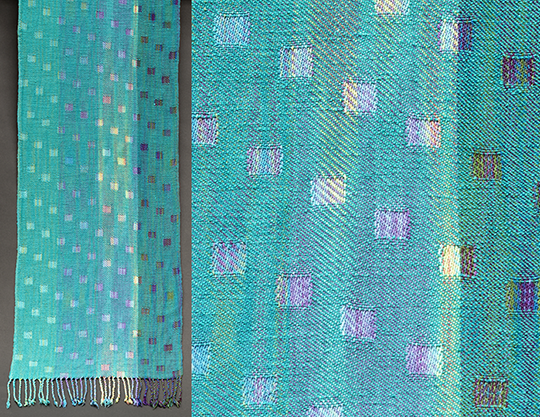Satins and Damasks – and Convergence® 2018!
Marcy Petrini
July, 2017
Before we go back to thinking about satins and damasks, I would like to report some exciting news: I have been accepted to present at Convergence® 2018 in Reno, Nevada. Here are the classes:
|
Class Title |
Hours |
Class Type |
|
A Pictionary of Weaving Structures |
3 |
3-Hour Seminar |
|
A Weaving Year of Wonder (4 Shafts) |
6 |
1-Day Workshop |
|
There is Nothing Plain about Plain Weave |
3 |
3-Hour Seminar |
|
Your Fabric is Not Always a Painting |
1.5 |
90-Minute Seminar |
I hope my classes will be well attended and I hope to see you next July 6 – 18, 2018 in Reno.
In the June blog, we saw a scarf that has blocks of sateen and satins on both sides of the fabric. When blocks of satin are combined, the resulting fabric is called a damask; each block can be woven either warp or weft dominant. Another example is below.

Similarly, on 8-shafts, we can weave two blocks of false satin, or a false damask.
There is one issue we need to consider when combining blocks in either satins or false-satins: floats where the blocks join.
Let’s think of how these flats are formed. In the 5-shaft satin drawdown in the June blog, we used the step to arrive at the threading; then we tied the loom in a straight draw, one shaft at a time, for the weft-dominant, or sateen side:

And then we treadled in order. As we saw, the resulting floats are 4-thread long.
It makes sense that to obtain the warp-dominant, or satin side, we could tie all of the shafts minus one, the “minus one” in the same order as for the sateen side; that is, for the sateen side, our first treadle is 1; for the satin side the first treadle is tied to everything but 1. Below is what we used for the draft in the June blog:

In combining the blocks and weaving them either warp or weft dominant, we can use that approach; each block is at least 5 shafts; the same step can be used for each block. Below is the drawdown, showing block A in pink, with three repeat of the step-2 satin. Block B is in green, same step, also with three repeats, using shafts 6 through 10.
Then we use the tie-up for the satin and sateen as we discussed above, but for each block, so that when one block weaves satin, the other weaves sateen and vice versa.
And finally we treadle each block, repeating the sequence as many times as we wish.

Click here for the full-sized draft (a PDF will open in a new window).
If we look closely at adjacent blocks, both horizontally and vertically, we see that our “rule” of a 4-thread float is broken: there are several places where the warp or weft floats are 5-thread long. While this may not be an issue in terms of float length – a 5-thread float may be fine for the intended use of the fabric – it is a disruption of the satin structure.
What we can do to return the 5-shaft satin blocks to 4-thread floats it to rearrange the tie-up. What I like to do is keep the sateen tie-up as a straight draw, but change the satin tie-up so that the “minus one” shaft is shifted by one treadle, as shown in the tie-up below:

When we apply this tie-up to the threading and treadling of the previous example, all the floats are never longer than 4 threads as can be seen in the following drawdown. This is why published drafts of satins and damasks may have an offset tie-up, sometimes shown in the treadling or in the lift plan.
The drawdown below also shows that we can weave both blocks as sateen and both blocks as satin, but we can quickly run out of treadles.

Click here for the full-sized draft (a PDF will open in a new window).
Similarly, we can derive the tie-up for false damask, using blocks of 3/1 broken twill. Below is the drawdown with two blocks and all the treadling possibilities.

Click here for the full-sized draft (a PDF will open in a new window).
As I mentioned before, these fabrics are denser: for any given yarn, the warp must be set more closely to obtain an appropriate warp-dominant side; and the beat must be higher to obtain an appropriate weft-dominant side. If your fabric is too heavy, try using yarns of smaller grist. The long floats provide lots of drape which can be accentuated by using slick yarns like the traditional silk, but also the newer fibers like Tencel® and bamboo. The shawl shown above was woven using 10/2 Tencel® from Convergence® 2014 and it has a nice drape, despite the fact that the yarn is not particularly thin.
Happy exploring satins and damasks!
Please email comments and questions to